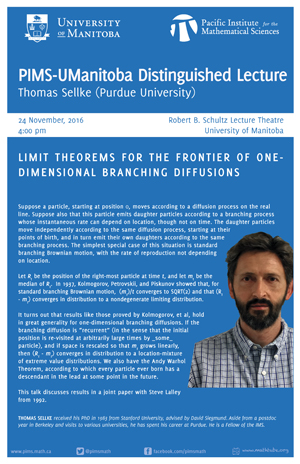PIMS-UManitoba Distinguished Lecture: Thomas Sellke
Topic
Speakers
Details
This talk will discuss results in a joint paper of mine with Steve Lalley from 1992.
Suppose a particle, starting at position 0, moves according to a diffusion process on the real line. Suppose also that this particle emits daughter particles according to a branching process whose instantaneous rate can depend on location, though not on time. The daughter particles move independently according to the same diffusion process, starting at their points of birth, and in turn emit their own daughters according to the same branching process. The simplest special case of this situation is standard branching Brownian motion, with the rate of reproduction not depending on location.
Let R_t be the position of the right-most particle at time t, and let m_t be the median of R_t. In 1937, Kolmogorov, Petrovskii, and Piskunov showed that, for standard branching Brownian motion, (m_t)/ t converges to SQRT(2) and that (R_t - m_t) converges in distribution to a nondegenerate limiting distribution.
It turns out that results like those proved by Kolmogorov, et al, hold in great generality for one-dimensional branching diffusions. If the branching diffusion is "recurrent" (in the sense that the initial position is re-visited at arbitrarily large times by _some_ particle), and if space is rescaled so that m_t grows linearly, then (R_t - m_t) converges in distribution to a location-mixture of extreme value distributions. We also have the Andy Warhol Theorem, according to which every particle ever born has a descendant in the lead at some point in the future.
A video of this event is available on mathtube.org.
Additional Information
Thomas Sellke (Purdue University)

